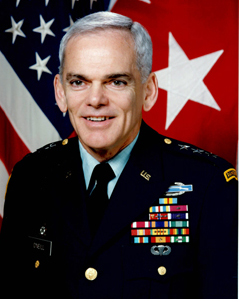Lieutenant General
Malcolm R. O'Neill
 Malcolm R.
O'Neill was born in Chicago in 1940 and commissioned through the ROTC program at DePaul University in 1962.
He was initially detailed to Field Artillery and served as a forward observer and liaison officer in the
82nd Airborne Division at Fort Bragg from 1962 to 1964. Following graduation from the US Army Ordnance
Guided Missile School at Redstone Arsenal, he volunteered for duty in South Vietnam and served as Senior
Advisor to the Reconnaissance Company of the 21st ARVN Division from 1965 to 1966.
Malcolm R.
O'Neill was born in Chicago in 1940 and commissioned through the ROTC program at DePaul University in 1962.
He was initially detailed to Field Artillery and served as a forward observer and liaison officer in the
82nd Airborne Division at Fort Bragg from 1962 to 1964. Following graduation from the US Army Ordnance
Guided Missile School at Redstone Arsenal, he volunteered for duty in South Vietnam and served as Senior
Advisor to the Reconnaissance Company of the 21st ARVN Division from 1965 to 1966.
When O'Neill returned to the States in 1966, he served as an instructor at the Ordnance Guided Missile School and then as aide-de-camp to the Commanding General, US Army Missile Command. Upon completion of the Ordnance Officer Advanced Course, he attended Rice University and earned an MA in Physics. In 1970, he returned to Vietnam, serving as Assistant Chief of Staff, Ammunition, Da Nang Support Command, where he oversaw the storage and distribution of the 100,000 tons of ammunition in the Command's ammunition supply points.
When he returned to the States again in 1971, O'Neill attended the Army Command and General Staff College and was awarded a fellowship which enabled him to return to graduate school at Rice University. In 1974, following completion of the requirements for his PhD in Physics, he was selected first as the Project Manager for Laser Phenomenology, Missile Command, where he was involved in the use of powerful lasers in close combat, air defense, and air-to-ground engagements; and then as Program Manager, Strategic Fire Control Systems Defense Advanced Research Projects Agency (DARPA), where he carried out pioneering work using space-based lasers to destroy incoming ICBMs.
Following completion of the Army War College in 1981, he served as Deputy Project Manager, NATO Patriot Project Office, where he arranged Patriot missile co-production agreements with the Dutch and Germans, and then, in 1983, as the Chief of Staff, Missile Command. However, he was almost immediately board-selected to be the next Multiple Launch Rocket System (MLRS) Project Manager. Charged with responsibility for this $14 billion program, he not only fielded the system to the first non-divisional MLRS battalion at Fort Hood, Texas, as well as divisional units in Germany, Korea, and Hawaii; but was also instrumental in implementing system improvements and in developing a new family of ammunition rounds.
In 1985, Vice Chief of Staff of the Army, Maxwell R. Thurman, selected O'Neill to join President Ronald Reagan's new Strategic Defense Initiative Office (SDIO), commonly known as the Star Wars Program. As a result, O'Neill was placed in charge of the largest of the four Star Wars directorates, the Kinetic Energy Weapons Directorate, which was responsible for developing hit-to-kill missiles employing kinetic energy warheads. During his tenure in this position, the Directorate developed the first kinetic energy weapon to kill a maneuvering space object.
In 1987, O'Neill assumed command of the US Army Laboratory Command at Adelphi, Maryland, where he was dual-hatted as Deputy Chief of Staff for Research, Development, and Acquisition, Army Materiel Command (AMC). In this capacity, he commanded seven laboratories and managed AMC's research, development, testing, and evaluation budget. At the conclusion of this command, he served in the Office of the Assistant Secretary of the Army for Research, Development, and Acquisition where he was responsible for directing a wide range of R&D programs and charged with organizing the Army's Acquisition Corps.
In 1991, O'Neill became the Deputy and Acting Director, SDIO. Much to his credit, when SDIO subsequently became threatened with the prospect of being dismantled, he persuaded the administration to reconsider its value and reestablish it as the Ballistic Missile Defense Organization. As the first Director, BMDO, he testified dozens of times on Capitol Hill and traveled all over the world persuading our allies of the importance of theater missile defense.
LTG O'Neill retired in 1996 after 34 years of distinguished service that included an unprecedented 200 months of program management and research experience.